An important part of the Warhorse Project is determining where the horses were born in order to reconstruct the movement of the horses throughout their lives. Key to this is stable isotope analysis, including strontium. In this blog post, we will introduce you to how the Warhorse team samples medieval horse teeth for strontium isotope analysis.
Strontium isotopes (87Sr/86Sr) can provide the location of birth in animals, including people and horses, as well as their mobility in life. As tooth enamel is formed during childhood when animals eat or drink, it records this chemical isotope from the local bedrock. This bedrock varies throughout the UK, giving us various ranges of 87Sr/86Sr, as seen below.
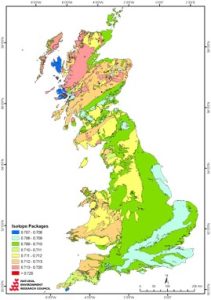
Map of strontium isotopic variation across the United Kingdom from Evans et al. (2010:2, Fig. 1b).
We take samples from horse teeth to compare to these ranges to determine where they were born within, or even outside of, the UK. The process involves the following steps, shown here with the Elverton Street horses from the Museum of London Archaeology (MOLA).
Step 1: Choose teeth from different individuals and different archaeological contexts throughout a particular archaeological site. The goal is to get an understanding of the place of birth and life histories of as many horses as possible.
Step 2: Take photographs and measurements to record the teeth before sampling, as it is a destructive method. Each sampled tooth is assigned an ID number. This is a lower (mandibular) 3rd molar from a horse that is approximately 9-10 years old, ID ELV2.
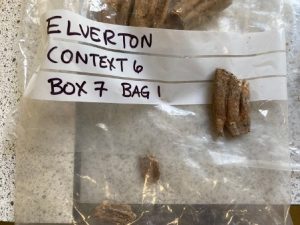
Horse tooth from Elverton prior to sampling.
Step 2: Cut strips of enamel from the horse molars. We use the 2nd and 3rd molars for this. Dremels with thin, precision drill bits are used for this process.
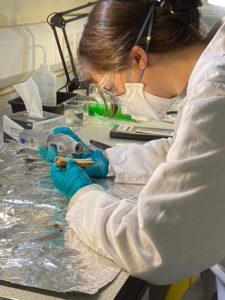
Warhorse team member, Tess Townend, cutting strips of horse teeth with enamel in the isotope prep lab.
Step 3: Photograph again to make sure we know which strips belong to which tooth (and which individual and context).
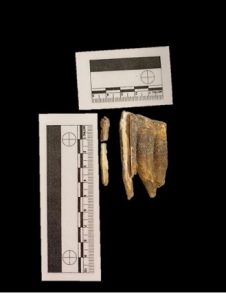
Horse tooth sample ELV2 after strip is cut.
Step 4: Label, draw, and measure the tooth and the resultant strips.
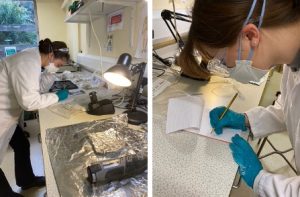
Tess recording the measurements and making the drawings of the sampled teeth and strips.
Steps 5 & 6: Glue strips of enamel to paper in a ring shape, and draw a map of which teeth are where in the ring. The map is critical to be able to match the strontium isotope ratio to the particular horse.
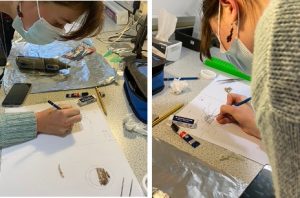
Tess placing and mapping the strips of horse teeth.
Step 7: Fill the ring with the strips of teeth. The teeth have to fit inside the ring in order to fit in the mass spectrometer which measures the strontium.
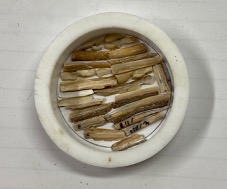
Sampled strips of horse teeth in plastic ring.
Step 8: Pour a two-part epoxy resin over the strips, and leave to harden overnight.
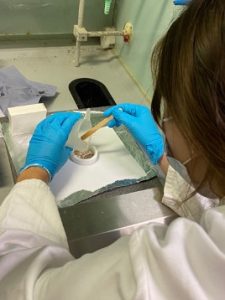
Tess pouring a two-part epoxy resin over the strips of horse teeth.
Step 9: End up with a hardened resin disc with the strips of teeth in it. We have teeth from 17 different horses in two discs!
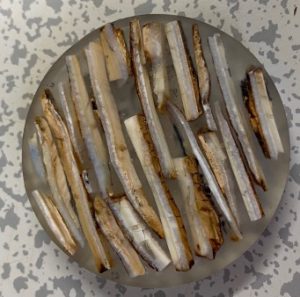
Resin disc with sampled strips of horse teeth.
Step 10: Photograph the disc again to produce a final map.
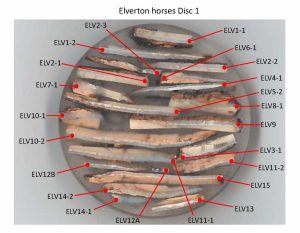
Map of sampled teeth for strontium isotope analysis.
After the teeth are sampled and prepared, Dr Alex Pryor, archaeologist and University of Exeter isotope specialist, will be undertaking the analysis using Laser Ablation Multi-Collector Inductively Coupled Plasma Mass Spectrometry (LA-MC-ICPMS) located in the Plasma Mass Spectrometer Laboratory, National Oceanography Centre, University of Southampton, UK. Once he has finished this analysis, Dr Pryor will help the Warhorse team interpret the results to gain an understanding of where the horses in the project were born and may have traveled during their lives.
Reference
Evans, J. A., Montgomery, J., Wildman, G. & Boulton, N. 2010. Spatial variations in biosphere 87Sr/86Sr in Britain. Journal of Geological Society, London 167:1–4.
This looks like a useful tool, what is the accuracy for both location and dating from Strontium testing? Does Sr-90 exposure during our modern age affect your results?
Hi John, thank you for your questions. Isotope analyses are very useful indeed but, as all methods, they do have their problems, e.g. when more than one region has a similar soil composition. There are plenty of articles exploring exactly those kinds of issues you mention if you want to delve into it a bit more.